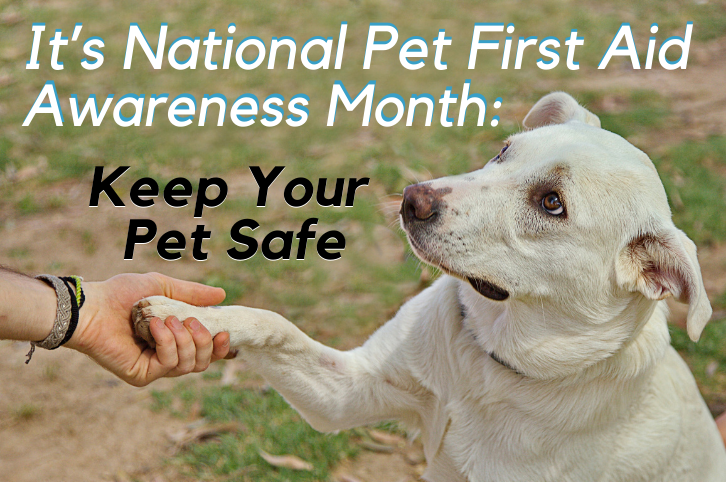Are you prepared to provide first aid to your pet if needed? April is National Pet First Aid Awareness Month. This means there’s no better time than the present to learn the basics of pet first aid. Learning some first aid tips and preparing a pet-ready first aid kit could save your pet’s life. What should all pet parents know in case of an emergency?
1. Prevention is Always the Best Option
In a perfect world, pet parents would never need to perform first aid. Unfortunately, that’s not the case. Luckily, there are preventative measures every pet owner can take to help keep their pet safe, healthy, and out of danger.
Here are some preventative steps we recommend you complete this month:
- Place all potential poisons out of your pet’s reach.
- Do not skip your pet’s preventative medicines like flea, tick, and heartworm medications.
- Walk your yard and remove any potentially dangerous items (shovels, trowels, hoes, insecticides, etc.).
- Do not skip your pet’s annual or bi-annual exams.
- Always provide your pet with fresh water, especially on walks.
- Create a shaded place for your pet to relax in the backyard.
2. Know How to Respond to Heatstroke
As the weather warms, the cases of pet heatstroke and heat exhaustion increase. If you notice your pet showing the signs of heatstroke (red gums, disorientation, excessive panting, vomiting, loss of consciousness), follow these steps:
- Remove your pet from the heat.
- Call us right away.
- Do not dip your pet in cold water or give them aspirin.
- Let your pet drink cool water.
- Wrap them in a damp towel or dip them in room temperature water.
- Head in to see us immediately.
3. Learn to Respond to Pet Injuries
No matter how cautious you are, there is a chance your pet may experience a serious injury. Whether it’s a broken bone, burn, or severe cut, you can prepare by knowing what to do in these situations.
Excessive Bleeding:
- Muzzle your pet and restrain them with a blanket. Even the sweetest, calmest pet can panic and react negatively when injured. Wrapping your dog or cat in a towel or blanket can help keep them still and controlled.
- Press a clean piece of gauze or cloth wrap over the wound. Apply firm pressure. Monitor after three minutes to see if the wound started to clot.
- Call us and bring your pet in ASAP.
For extreme bleeding, tie a tourniquet between the body and the wound, follow the steps listed above and come in immediately.
A Possible Bone Break:
- Use a muzzle and swaddle your pet to prevent excessive movement.
- Place your pet on something you can use a stretcher: an ironing board, bulletin board, etc. Place a blanket over your pet and ask someone else for help keeping your pet still if possible.
- Call us and come in.
Burns:
- Chemical burns should be flushed with a lot of water
- Heat burns are best treated with icy water, followed by an ice compress.
Bring your pet in. They will likely need an antibiotic.
4. Prepare a Pet-Ready First Aid Kit
If you have a first aid kit for use on people, it likely has peroxide, gauze, gloves, and bandages. This means you only need to add a few things to make your first aid kit pet-ready. We recommend adding:
- Tweezers
- Dishwashing soap
- Towels
- A flashlight
- Styptic powder
- Saline eye solution
- A muzzle
- Wound wrap
5. Don’t Hesitate to Call Homey Gnome
Accidents happen. Dogs tend to swallow non-edible items like socks and other pets wind up in trouble, as well. We’ve seen it all.
We are here to help you and your pet. If you are ever unsure if your pet needs veterinary care, please give us a call. We are happy to chat about the situation and provide you with our best judgment regarding your pet’s emergency or non-emergency vet care.
You Are Your Pet’s First Responder
We hope this article gave you valuable insight on how you can keep your pet safe, no matter the circumstances. While we hope you never need to use first aid, it’s always a good idea to know how to, just in case. If you have questions or need assistance with your pet, please give us a call or schedule an appointment now.
Image credit: Pixabay


